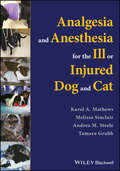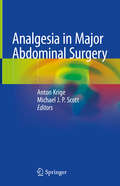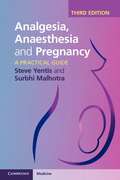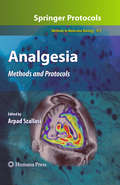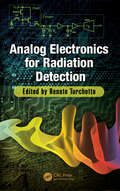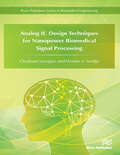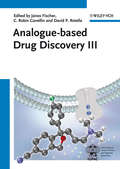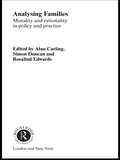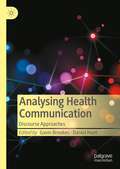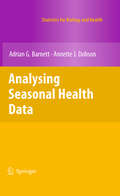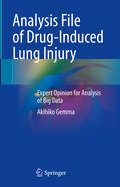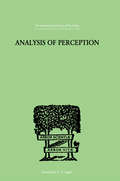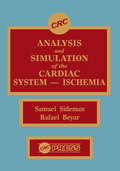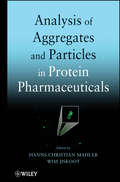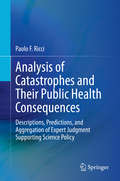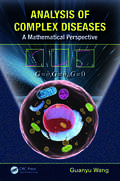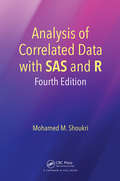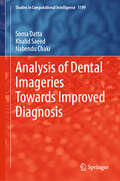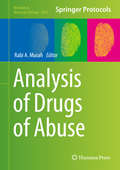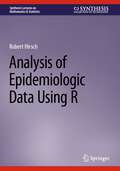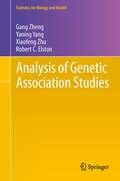- Table View
- List View
Analgesia and Anesthesia for the Ill or Injured Dog and Cat
by Karol A. Mathews Melissa Sinclair Andrea M. Steele Tamara GrubbAnalgesia and Anesthesia for the Ill or Injured Dog and Cat provides a comprehensive guide to anesthesia and pain management protocols, specifically tailored to ill or critically injured dogs and cats. Provides fast access to anesthesia and pain management protocols specifically tailored to ill or critically injured dogs and cats Takes a case-based structure to make it easy to find and apply relevant information Presents step-by-step clinical procedures and techniques Supplies concise, relevant background information for all drugs recommended in the protocols, highlighting recommendations and cautions for specific patient conditions Includes detailed information for geriatric, pregnant, nursing, and pediatric patients and those with cardiac, liver or kidney pathology
Analgesia in Major Abdominal Surgery
by Anton Krige Michael J. ScottThis book presents current evidence in an Enhanced Recovery Programme context, and provides a common sense approach to using the array of available analgesia techniques appropriately in major abdominal surgery. Current pain relief options are discussed, many of which have been described only in the last ten years. Topics covered range from the now widespread use of portable ultrasound machines to an appreciation of the value of some older drugs in a new context. Analgesia for Major Abdominal Surgery is aimed at anesthetists, acute pain teams, and acute pain nurses, as well as colorectal, hepatobiliary, urological and gynecological surgeons.
Analgesia, Anaesthesia and Pregnancy
by Steve Yentis Surbhi MalhotraAnalgesia, Anaesthesia and Pregnancy focuses on pre-empting problems and maximising quality of care. Every chapter of this well-established practical guide has been completely updated and revised. All aspects of obstetric medicine relevant to the anaesthetist are covered, from pre-pregnancy management to conception, throughout pregnancy, to postnatal care. The authors have identified over 150 potential complications, each covered in two parts: 'problems/special considerations' and 'management options', with key points prominently displayed for quick reference. A section on organisational aspects such as record keeping, training protocols and guidelines makes this an important resource for any labour ward or hospital dealing with pregnant women. Presented in a clear, structured format, this practical summary will be invaluable to any anaesthetist encountering obstetric patients, whether they are a practiced consultant or still in training. It will also be useful for obstetricians, neonatologists, midwives, nurses and operating department practitioners wishing to extend or update their knowledge.
Analgesia, Anaesthesia and Pregnancy: A Practical Guide
by Steve Yentis Surbhi Malhotra Róisín Monteiro Marwa SalmanNow in its fourth edition, Analgesia, Anaesthesia and Pregnancy is a concise guide to obstetric anaesthesia and analgesia. This essential text reviews every topic and clinical challenge faced during delivery and focuses on pre-empting problems and maximising quality of care. It also covers acute emergencies related to pregnancy. This new edition features 11 new chapters that cover the significant updates in the field over the last few years. Presented in a clearly structured format, this practical guide will be an invaluable source of key information for any anaesthetist encountering obstetric patients, whether they are a practised consultant or still in training. Obstetricians, neonatologists, midwives, nurses, and anaesthetic assistants in obstetric analgesia and anaesthesia who wish to extend or update their knowledge will also benefit from reading this book.
Analgesia: Methods and Protocols (Methods in Molecular Biology #617)
by Arpad SzallasiChronic pain is a complex phenomenon, which continues to remain undertreated in the majority of affected patients thus representing a significant unmet medical need, but the development of cellular, subcellular, and molecular methods of approaching this epidemic of pain shows great promise. In Analgesia: Methods and Protocols, experts in the field present thorough coverage of molecular analgesia research methods from target discovery through target validation and clinical testing to tolerance and dependence, with extensive chapters on emerging receptor classes as targets for analgesic drugs and innovative analgesic strategies. As a volume in the highly successful Methods in Molecular BiologyTM series, the chapters include introductions to their respective topics, lists of the necessary materials and reagents, step-by-step, readily reproducible protocols, and notes sections with tips on troubleshooting and avoiding known pitfalls. Comprehensive and essential, Analgesia: Methods and Protocols promises to aid and enrich the research of all those scientists and clinicians who are interested in what the increasingly molecular future has in store for analgesia research, from the molecular research bench through the animal laboratory to the bedside.
Analog Electronics for Radiation Detection (Devices, Circuits, and Systems)
by Renato TurchettaAnalog Electronics for Radiation Detection showcases the latest advances in readout electronics for particle, or radiation, detectors. Featuring chapters written by international experts in their respective fields, this authoritative text: Defines the main design parameters of front-end circuitry developed in microelectronics technologies Explains the basis for the use of complementary metal–oxide semiconductor (CMOS) image sensors for the detection of charged particles and other non-consumer applications Delivers an in-depth review of analog-to-digital converters (ADCs), evaluating the pros and cons of ADCs integrated at the pixel, column, and per-chip levels Describes incremental sigma–delta ADCs, time-to-digital converter (TDC) architectures, and digital pulse-processing techniques complementary to analog processing Examines the fundamental parameters and front-end types associated with silicon photomultipliers used for single visible-light photon detection Discusses pixel sensors with per-pixel TDCs, channel density challenges, and emerging 3D technologies interconnecting detectors and electronics Thus, Analog Electronics for Radiation Detection provides a single source for state-of-the-art information on analog electronics for the readout of radiation detectors.
Analog IC Design Techniques for Nanopower Biomedical Signal Processing (River Publishers Series In Biomedical Engineering Ser.)
by Wouter A. Serdijn Chutham SawigunAs the requirements for low power consumption and very small physical dimensions in portable, wearable and implantable medical devices are calling for integrated circuit design techniques using MOSFETs operating in the subthreshold regime, this book first revisits some well-known circuit techniques that use CMOS devices biased in subthreshold in order to establish nanopower integrated circuit designs. Based on the these findings, this book shows the development of a class-AB current-mode sample-and-hold circuit with an order of magnitude improvement in its figure of merit compared to other state-of-the-art designs. Also, the concepts and design procedures of 1) single-branch filters 2) follower-integrator-based lowpass filters and 3) modular transconductance reduction techniques for very low frequency filters are presented. Finally, to serve the requirement of a very large signal swing in an energy-based action potential detector, a nanopower class-AB current-mode analog multiplier is designed to handle input current amplitudes of more than 10 times the bias current of the multiplier circuit. The invented filter circuits have been fabricated in a standard 0.18 µ CMOS process in order to verify our circuit concepts and design procedures. Their experimental results are reported.
Analogue-based Drug Discovery III
by Janos Fischer C. Robin Ganellin David P. RotellaMost drugs are analogue drugs. There are no general rules how a new drug can be discovered, nevertheless, there are some observations which help to find a new drug, and also an individual story of a drug discovery can initiate and help new discoveries. Volume III is a continuation of the successful book series with new examples of established and recently introduced drugs. The major part of the book is written by key inventors either as a case study or a study of an analogue class. With its wide range across a variety of therapeutic fields and chemical classes, this is of interest to virtually every researcher in drug discovery and pharmaceutical chemistry, and -- together with the previous volumes -- constitutes the first systematic approach to drug analogue development.
Analysing Families: Morality and Rationality in Policy and Practice
by Rosalind Edwards Alan Carling Simon DuncanWhile the family and its role continues to be a key topic in social and government policy, much of the literature is concerned with describing the dramatic changes that are taking place. By contrast, Analysing Families directly addresses the social processes responsible for these changes - how social policy interacts with what families actually do. Topics covered include:* the relationship between morality and rationality in the family context* the variety of contemporary family forms* the purposes and assumptions of government interventions in family life* the relationship between different welfare states and different ideas about motherhood* 'Third Way' thinking on families* divorce and post-divorce arrangements* lone parenthood and step-parenting* the decision to have children* the economic approach to understanding family process* the legitimacy of state intervention in family life.With contributions from the UK, and North America, Analysing Families provides the framework within which to understand an increasingly important element in social policy.
Analysing Health Communication: Discourse Approaches
by Gavin Brookes Daniel HuntThis edited book showcases original research in the study of healthcare and health communication, while also providing a detailed overview of contemporary methods of discourse analysis. Discourse approaches remain under-represented in the field of health communication, despite their potential for affording detailed understanding of health-related text and talk across an array of contexts, for example in face-to-face and digital healthcare encounters, health promotion, and patients’ accounts of illness experiences. This book aims to address this gap in the literature by offering the first book-length treatment of different approaches to discourse analysis in health(care) and illness contexts, and it will appeal both to linguists and to researchers in nursing and health sciences, sociology and anthropology.
Analysing Seasonal Health Data (Statistics for Biology and Health)
by Adrian G. Barnett Annette J. DobsonSeasonal patterns have been found in a remarkable range of health conditions, including birth defects, respiratory infections and cardiovascular disease. Accurately estimating the size and timing of seasonal peaks in disease incidence is an aid to understanding the causes and possibly to developing interventions. With global warming increasing the intensity of seasonal weather patterns around the world, a review of the methods for estimating seasonal effects on health is timely. This is the first book on statistical methods for seasonal data written for a health audience. It describes methods for a range of outcomes (including continuous, count and binomial data) and demonstrates appropriate techniques for summarising and modelling these data. It has a practical focus and uses interesting examples to motivate and illustrate the methods. The statistical procedures and example data sets are available in an R package called 'season'.
Analysis File of Drug-Induced Lung Injury: Expert Opinion for Analysis of Big Data
by Akihiko GemmaThis book describes the pathologic conditions of drug-induced lung injuries, monitoring strategies, and guides on how to interpret the evidence. It also dives into particular drugs that caused the disorder, such as EGFR inhibitors, anti-EGFR antibodies, mTOR inhibitors, proteasome inhibitors, immune checkpoint inhibitors, neoangiogenesis inhibitors, and other molecular targeted drugs. It outlines the analysis and interpretation of the post-marketing survey on surveillance of each drug for inducing pulmonary lesions presenting diffuse haziness. The data and analysis from this survey are valuable since a guideline is yet to be established due to limited clinical evidence and cases. As new drugs are developed, establishing treatment and event management is crucial. Thus, Drug-induced Pulmonary Disorder in Medical Oncology - Expert Opinion to Decipher Big Data summarizes the accumulated information to provide a foundation for further research advancement. The book offers a refreshing alternative to current approaches to medical oncology and respiratory diseases professionals and will also attract medical affairs members in global pharmaceutical companies.
Analysis Of Perception (International Library Of Psychology Ser.)
by Smythies, J RFirst published in 1999. Routledge is an imprint of Taylor & Francis, an informa company.
Analysis and Application of Analog Electronic Circuits to Biomedical Instrumentation (Biomedical Engineering Ser.)
by Robert B. NorthropAnalysis and Application of Analog Electronic Circuits to Biomedical Instrumentation, Second Edition helps biomedical engineers understand the basic analog electronic circuits used for signal conditioning in biomedical instruments. It explains the function and design of signal conditioning systems using analog ICs-the circuits that enable ECG, EEG,
Analysis and Data-Based Reconstruction of Complex Nonlinear Dynamical Systems: Using the Methods of Stochastic Processes (Understanding Complex Systems)
by M. Reza Rahimi TabarThis book focuses on a central question in the field of complex systems: Given a fluctuating (in time or space), uni- or multi-variant sequentially measured set of experimental data (even noisy data), how should one analyse non-parametrically the data, assess underlying trends, uncover characteristics of the fluctuations (including diffusion and jump contributions), and construct a stochastic evolution equation?Here, the term "non-parametrically" exemplifies that all the functions and parameters of the constructed stochastic evolution equation can be determined directly from the measured data.The book provides an overview of methods that have been developed for the analysis of fluctuating time series and of spatially disordered structures. Thanks to its feasibility and simplicity, it has been successfully applied to fluctuating time series and spatially disordered structures of complex systems studied in scientific fields such as physics, astrophysics, meteorology, earth science, engineering, finance, medicine and the neurosciences, and has led to a number of important results.The book also includes the numerical and analytical approaches to the analyses of complex time series that are most common in the physical and natural sciences. Further, it is self-contained and readily accessible to students, scientists, and researchers who are familiar with traditional methods of mathematics, such as ordinary, and partial differential equations.The codes for analysing continuous time series are available in an R package developed by the research group Turbulence, Wind energy and Stochastic (TWiSt) at the Carl von Ossietzky University of Oldenburg under the supervision of Prof. Dr. Joachim Peinke. This package makes it possible to extract the (stochastic) evolution equation underlying a set of data or measurements.
Analysis and Simulation of the Cardiac System Ischemia
by Rafael Beyar Samuel SidemanOver thiry-five experts contribute to this publication about the various interactions and interrelationships of the parameters which affect the normal and ischemic heart. Mechanical aspects related to the global and regional function of the heart are discussed. Coronary perfusion of the ischemic heart is considered, with emphasis on the effects of reperfusion. Electrical activation, formation of arrhythmias, and the effects of ischemia or ionic transport in the myocardium are presented. Metabolic aspects of the ischemic heart, including calcium transport, are also explained.
Analysis of Aggregates and Particles in Protein Pharmaceuticals
by Wim Jiskoot Hanns-Christian MahlerThis book describes how to address the analysis of aggregates and particles in protein pharmaceuticals, provides a comprehensive overview of current methods and integrated approaches used to quantify and characterize aggregates and particles, and discusses regulatory requirements. Analytical methods covered in the book include separation, light scattering, microscopy, and spectroscopy.
Analysis of Catastrophes and Their Public Health Consequences: Descriptions, Predictions, and Aggregation of Expert Judgment Supporting Science Policy
by Paolo F. RicciPublic health policy prospectively and retrospectively addresses the consequences of events ranging from the commonplace to the catastrophic. Informing policymakers and stakeholders by enhancing their understanding of complex causation to justify remedial or precautionary actions is a critical science-policy task. In this book, the key aspects of catastrophes (regardless of their nature) and routine events are identified through a common framework for their analyses, and the analyses of the consequences associated with the potential occurrence of these events also are discussed. The book is not about disaster planning; instead, it is focused on analysis and causation in the context of informing – rather than formulating – public health policy. The author aggregates and fuses scientific information and knowledge in public health policy-science using alternative but complementary methods. The book first focuses on the analysis of catastrophes and commonplace events; the focus then shifts to causal models of multifactorial diseases, particularly at low doses or dose-rates, associated with these events. Topics explored among the chapters include:Policy and Legal Aspects of Precautionary ChoicesCatastrophes, Disasters, and Calamities: Concepts for Their Assessment Uncertainty: Probabilistic and Statistical AspectsAggregating Judgments to Inform Precautionary Decision-makingThe aim of the book is to show that the analyses of events are fundamentally similar, regardless of whether the concern is a global catastrophe or commonplace. Analysis of Catastrophes and Their Public Health Consequences is a text that should engage students, instructors, and researchers in public health, science policy, and preparedness research, as well as serve as a useful resource for policy analysts, practitioners, and risk managers.
Analysis of Complex Diseases: A Mathematical Perspective
by PhD, Guanyu WangA complex disease involves many etiological and risk factors operating at multiple levels-molecular, cellular, organismal, and environmental. The incidence of such diseases as cancer, obesity, and diabetes are increasing in occurrence, urging us to think fundamentally and use a broader perspective to identify their connection and revolutionize trea
Analysis of Correlated Data with SAS and R
by Mohamed M. ShoukriAnalysis of Correlated Data with SAS and R: 4th edition presents an applied treatment of recently developed statistical models and methods for the analysis of hierarchical binary, count and continuous response data. It explains how to use procedures in SAS and packages in R for exploring data, fitting appropriate models, presenting programming codes and results. The book is designed for senior undergraduate and graduate students in the health sciences, epidemiology, statistics, and biostatistics as well as clinical researchers, and consulting statisticians who can apply the methods with their own data analyses. In each chapter a brief description of the foundations of statistical theory needed to understand the methods is given, thereafter the author illustrates the applicability of the techniques by providing sufficient number of examples. The last three chapters of the 4th edition contain introductory material on propensity score analysis, meta-analysis and the treatment of missing data using SAS and R. These topics were not covered in previous editions. The main reason is that there is an increasing demand by clinical researchers to have these topics covered at a reasonably understandable level of complexity. Mohamed Shoukri is principal scientist and professor of biostatistics at The National Biotechnology Center, King Faisal Specialist Hospital and Research Center and Al-Faisal University, Saudi Arabia. Professor Shoukri’s research includes analytic epidemiology, analysis of hierarchical data, and clinical biostatistics. He is an associate editor of the 3Biotech journal, a Fellow of the Royal Statistical Society and an elected member of the International Statistical Institute.
Analysis of Data from Randomized Controlled Trials: A Practical Guide
by Jos W.R. TwiskThis book provides a practical guide to the analysis of data from randomized controlled trials (RCT). It gives an answer to the question of how to estimate the intervention effect in an appropriate way. This problem is examined for different RCT designs, such as RCTs with one follow-up measurement, RCTs with more than one follow-up measurement, cluster RCTs, cross-over trials, stepped wedge trials, and N-of-1 trials. The statistical methods are explained in a non-mathematical way and are illustrated by extensive examples. All datasets used in the book are available for download, so readers can reanalyse the examples to gain a better understanding of the methods used. Although most examples are taken from epidemiological and clinical studies, this book is also highly recommended for researchers working in other fields.
Analysis of Dental Imageries Towards Improved Diagnosis (Studies in Computational Intelligence #1199)
by Khalid Saeed Nabendu Chaki Soma DattaThis book provides an insight on different types of hardware and software-based caries detection methods and their limitations from treatment perspective. The different chapters are motivated to address some of the important gaps in the prevailing approaches and suggest suitable solution to them. Overall, it helps the reader to understand the caries detection methods to identify interproximal and occlusal caries. This also assists the practitioners. The book identifies multiple research issues on dental caries detection that open the practitioners’ horizons to an array of domains from which they can conclude practical insights about their area of interest.
Analysis of Drugs of Abuse (Methods in Molecular Biology #1810)
by Rabi A. MusahThis volume features a comprehensive set of protocols featuring a range of both old and new technologies that can be used to analyze drugs of abuse, including prescription drugs, new psychoactive substances and psychoactive plants. Chapters guide readers through the application of color tests, light microscopy-based particle imaging, GC-MS, Raman spectroscopy, capillary electrophoresis, ultra-high performance LC-tandem MS, DART-MS, MALDI-mass spectrometry imaging, LC-MS/MS and HPLC-ESI-MS/MS to the analysis of abused drugs in wastewater, hair, urine and plant-derived materials, among other matrices. Written in the highly successful Methods in Molecular Biology series format, chapters include introductions to their respective topics, lists of the necessary materials and reagents, step-by-step, readily reproducible laboratory protocols, and tips on troubleshooting and avoiding known pitfalls.Authoritative and cutting-edge, Analysis of Drugs of Abuse aims to ensure successful results in the further study of this vital field.
Analysis of Epidemiologic Data Using R (Synthesis Lectures on Mathematics & Statistics)
by Robert HirschThis book addresses the description and analysis of occurrence data frequently encountered in epidemiological studies. With the occurrence of Covid-19, people have been exposed to the analysis and interpretation of epidemiological data. To be informed consumers of this information, people need to understand the nature and analysis of these data. Effort is made to emphasize concepts rather than mathematics. Subjects range from description of the frequencies of disease to the analysis of associations between the occurrence of disease and exposure. Those analyses begin with simple associations and work up to complex relationships that involve the control of extraneous characteristics. Analyses rely on the statistical software R, which is freeware in wide use by professional epidemiologists and other scientists.
Analysis of Genetic Association Studies (Statistics for Biology and Health)
by Gang Zheng Xiaofeng Zhu Yaning Yang Robert C. ElstonAnalysis of Genetic Association Studies is both a graduate level textbook in statistical genetics and genetic epidemiology, and a reference book for the analysis of genetic association studies. Students, researchers, and professionals will find the topics introduced in Analysis of Genetic Association Studies particularly relevant. The book is applicable to the study of statistics, biostatistics, genetics and genetic epidemiology. In addition to providing derivations, the book uses real examples and simulations to illustrate step-by-step applications. Introductory chapters on probability and genetic epidemiology terminology provide the reader with necessary background knowledge. The organization of this work allows for both casual reference and close study.
